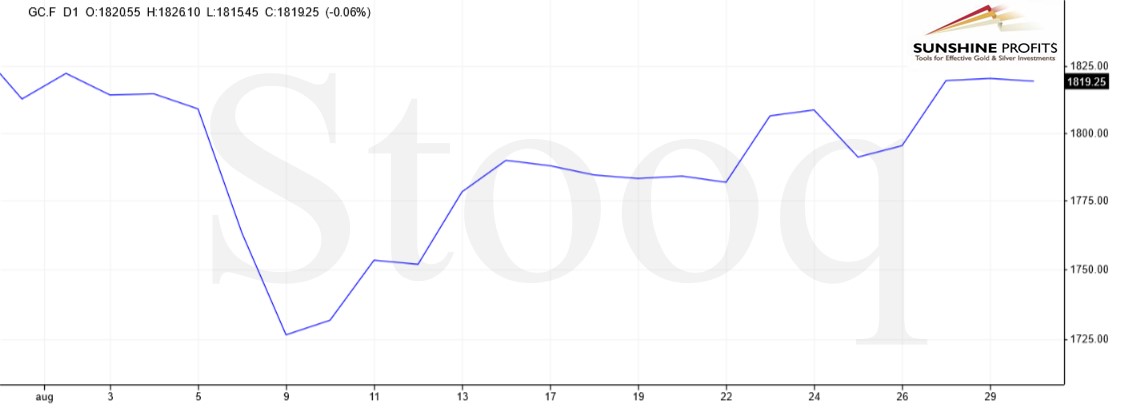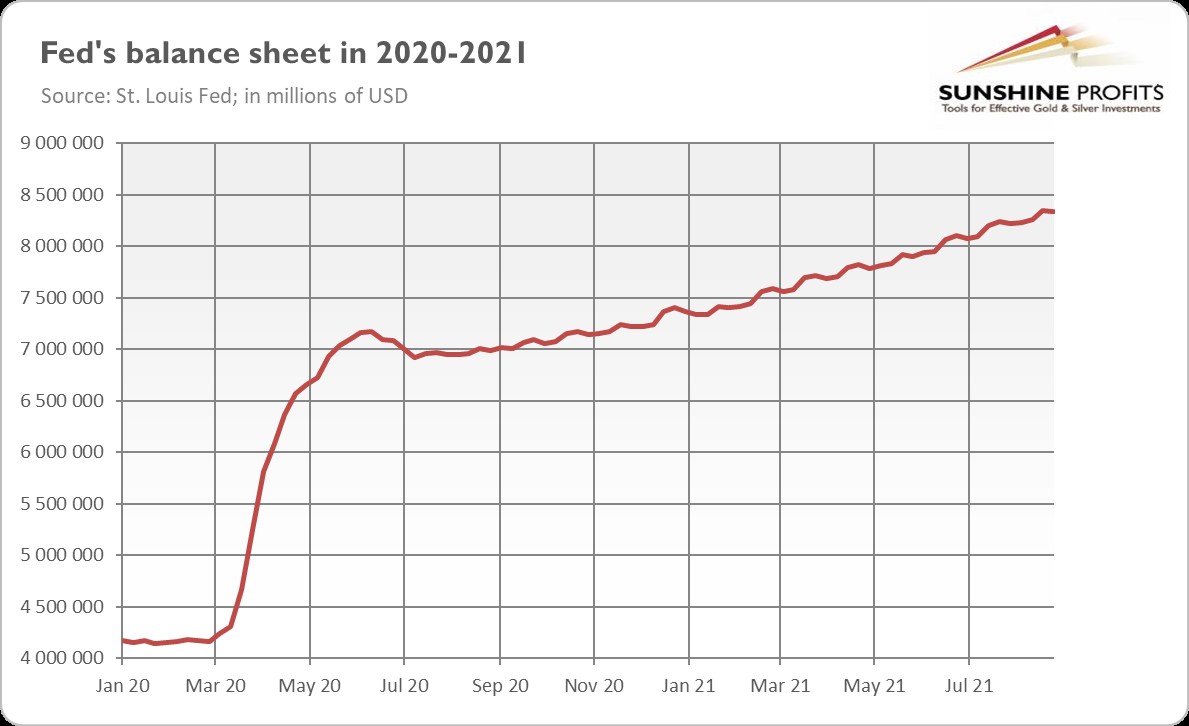Gold Moves Above $1,800 After Jackson Hole
The Jackson Hole is over — we left it in the rearview mirror. Gold moved higher in an immediate reaction, but bullish joy may be premature.
The 2021 Jackson Hole Economic Symposium “Macroeconomic Policy in an Uneven Economy” is already a thing of the past. It was a stimulating conference with a few interesting presentations. But the key appearance for the financial markets was Powell’s speech. Let’s dig into it!
So, the Fed Chair started his remarks with the observation that even though the pandemic recession was the briefest yet deepest on record, the pace of the recovery has exceeded expectations. That being said, the economic expansion has been uneven, and its continuation is threatened by the Delta variant of the coronavirus, high inflation and the remaining slack in the labor market. However, Powell was generally optimistic about the future, saying that the prospects were good for continued progress toward maximum employment, while the elevated inflation would likely be temporary:
The baseline outlook is for continued progress toward maximum employment, with inflation returning to levels consistent with our goal of inflation averaging 2 percent over time.
Actually, Powell was so optimistic about the US economy that he stated that the criteria for tapering of the quantitative easing had been met. The key passage from his speech is as follows:
We have said that we would continue our asset purchases at the current pace until we see substantial further progress toward our maximum employment and price stability goals, measured since last December, when we first articulated this guidance. My view is that the "substantial further progress" test has been met for inflation. There has also been clear progress toward maximum employment. At the FOMC's recent July meeting, I was of the view, as were most participants, that if the economy evolved broadly as anticipated, it could be appropriate to start reducing the pace of asset purchases this year. The intervening month has brought more progress in the form of a strong employment report for July, but also the further spread of the Delta variant. We will be carefully assessing incoming data and the evolving risks. Even after our asset purchases end, our elevated holdings of longer-term securities will continue to support accommodative financial conditions.
This passage is clearly hawkish, as it implies that the Fed will probably end its asset purchases this year if nothing bad happens.
However, the price of gold futures increased on Friday (after Powell’s remarks) from around $1,790 to almost $1,820, as the chart below shows. Why? Well, it seems that the markets read between the lines and interpreted the Fed Chair’s speech as actually quite dovish, or less hawkish than expected.
After all, Powell didn’t present any clear timeline of the Fed’s tightening cycle. Although the Fed Chair mentioned that it could be appropriate to start reducing the pace of asset purchases this year, he also noted some uncertainty about the spread of Delta and its economic aspect.
What’s more, Powell reminded the public that the tapering doesn’t automatically imply hiking the federal funds rate, as raising interest rates would require much more progress towards the Fed’s goals:
The timing and pace of the coming reduction in asset purchases will not be intended to carry a direct signal regarding the timing of interest rate liftoff, for which we have articulated a different and substantially more stringent test. We have said that we will continue to hold the target range for the federal funds rate at its current level until the economy reaches conditions consistent with maximum employment, and inflation has reached 2 percent and is on track to moderately exceed 2 percent for some time. We have much ground to cover to reach maximum employment, and time will tell whether we have reached 2 percent inflation on a sustainable basis.
So, we will not see higher interest rates anytime soon, despite higher inflation. This is clearly a dovish signal, and it supports gold prices. After all, the Fed’s monetary policy will remain accommodative, even after the start of tapering. The Fed will still be purchasing assets — the only difference is that it will do so at a slower pace, which means that its balance sheet will remain enormous (see the chart below), implying still large reinvestments of principal repayments.
Implications for Gold
What does it all mean for the gold market? Well, although Powell stated that the Fed’s test of “substantial further progress” had been met for inflation and suggested that it would soon be met for employment as well, his speech didn’t include any revolutionary insights. And, more importantly, it didn’t include any tapering statement. As a result, gold caught its breath.
However, the bullish joy may be premature. The Fed is likely to taper this year, especially if August nonfarm payrolls prove to be strong. Also, the FOMC may issue a tapering statement after its September meeting, announcing the start of reducing the pace of asset purchases in the last quarter of the year. So, the downward pressure on gold prices could stay with us in 2021. On the other hand, the Fed clearly pointed out that the timeline for tapering is not the timeline for interest rates, which could stay at ultra-low levels for months, if not years, working in favor of gold.
If you enjoyed today’s free gold report, we invite you to check out our premium services. We provide much more detailed fundamental analyses of the gold market in our monthly Gold Market Overview reports and we provide daily Gold & Silver Trading Alerts with clear buy and sell signals. In order to enjoy our gold analyses in their full scope, we invite you to subscribe today. If you’re not ready to subscribe yet though and are not on our gold mailing list yet, we urge you to sign up. It’s free and if you don’t like it, you can easily unsubscribe. Sign up today!
Arkadiusz Sieron, PhD
Sunshine Profits: Effective Investment through Diligence & Care
*******



















